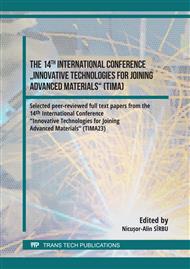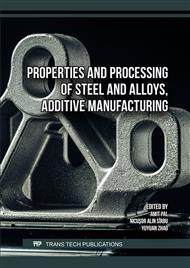[1]
Mohammad S. Alsoufi, State-of-the-Art in Abrasive Water Jet Cutting Technology and the Promise for Micro- and Nano-Machining, International Journal of Mechanical Engineering and Applications, 2017; 5(1): 1-14
DOI: 10.11648/j.ijmea.20170501.11
Google Scholar
[2]
Liu, H. "7M" Advantage of Abrasive Waterjet for Machining Advanced Materials. J. Manuf. Mater. Process. 2017, 1, 11.
DOI: 10.3390/jmmp1010011
Google Scholar
[3]
John Rozario Jegaraj J. and R. B. N., A soft computing approach for controlling the quality of cut with abrasive waterjet cutting system experiencing orifice and focusing tube wear. Journal of Materials Processing Technology, 2007. 185(1-3): pp.217-227.
DOI: 10.1016/j.jmatprotec.2006.03.124
Google Scholar
[4]
Shanmugam, D. K., J. Wang, and H. Liu, Minimization of kerf tapers in abrasive waterjet machining of alumina ceramics using a compensation technique. International Journal of Machine Tools and Manufacture, 2008. 48: pp.1527-1534.
DOI: 10.1016/j.ijmachtools.2008.07.001
Google Scholar
[5]
Shanmugam, D. K. and S. H. Masood, An investigation of kerf characteristics in abrasive waterjet cutting of layered composites. International Journal of Material Processing Technology 2009. 209: pp.3887-3893.
DOI: 10.1016/j.jmatprotec.2008.09.001
Google Scholar
[6]
Sachin Kumar Sharma, Anupam Bhatnagar, Analysis Of Kerf Geometry With Abrasive Water Jet Machine In Marble Processing, International Research Journal of Engineering and Technology (IRJET), Volume: 09 Issue: 02, Feb 2022, pp.663-668.
Google Scholar
[7]
Badgujar, P. P. and M. G. Rathi, Abrasive Waterjet Machining-A State of Art IOSR Journal of Mechanical and Civil Engineering (IOSR-JMCE) 2014. 11(3): pp.59-64.
DOI: 10.9790/1684-11365964
Google Scholar
[8]
Mohamed, M. A. K., Waterjet Cutting up to 900 MPa. 2004, Universität Hannover, Germany. pp.1-136.
Google Scholar
[9]
Ćojbašić, Ž., et al., Surface roughness prediction by extreme learning machine constructed with abrasive water jet. Precision Engineering, 2016. 43: pp.86-92.
DOI: 10.1016/j.precisioneng.2015.06.013
Google Scholar
[10]
Shiou, F.-J. and A. Asmare, Parameters optimization on surface roughness improvement of Zerodur optical glass using an innovative rotary abrasive fluid multi-jet polishing process. Precision Engineering, 2015. 42: pp.93-100.
DOI: 10.1016/j.precisioneng.2015.04.004
Google Scholar
[11]
Löschner, P., K. Jarosz, and P. Niesłony, Investigation of the Effect of Cutting Speed on Surface Quality in Abrasive Water Jet Cutting of 316L Stainless Steel. Procedia Engineering, 2016. 149: pp.276-282.
DOI: 10.1016/j.proeng.2016.06.667
Google Scholar
[12]
Kartal, F., Z. Yerlikaya, and H. Gökkaya, Effects of machining parameters on surface roughness and macro surface characteristics when the machining of Al-6082 T6 alloy using AWJT. Measurement, 2017. 95: pp.216-222.
DOI: 10.1016/j.measurement.2016.10.007
Google Scholar
[13]
Duspara, M., et al., Influence of Abrasive Feeding and Cutting Direction on the Surface Roughness. Procedia Engineering, 2016. 149: pp.48-55.
DOI: 10.1016/j.proeng.2016.06.637
Google Scholar
[14]
Alsoufi, M. S., Mohammed W. Alhazmi, Hamza A. Ghulman, Shadi M. Munshi and Sufyan Azam. Surface Roughness and Knoop Indentation Micro-Hardness Behavior of Aluminium Oxide (Al2O3) and Polystyrene (C8H8)n Materials. International Journal of Mechanical & Mechatronics Engineering, 2016. 16(6): pp.43-49
Google Scholar
[15]
Suker, D. K., M. S. Alsoufi, M. M. Alhusaini, S. A. Azam, Studying the Effect of Cutting Conditions in Turning Process on Surface Roughness for Different Materials. World Journal of Research and Review (WJRR), 2016. 2(4): pp.16-21.
Google Scholar
[16]
Naik, M.B.; Srikanth, D.; Rao, M.S. Abrasive Jet Machining on Soda lime Glass-An experimental investigation. Int. J. Res. Publ. 2020, 44, 887.
Google Scholar
[17]
Liu, H.-T.P. Advanced waterjet technology for machining curved and layered structures. Curved Layer. Struct. 2019, 6, 41–56.
DOI: 10.1515/cls-2019-0004
Google Scholar
[18]
Information on https://jetedgewaterjets.com/
Google Scholar
[19]
Information on https://www.waterjetsweden.com/products/micro
Google Scholar
[20]
Information on https://www.finepart.com/products/
Google Scholar
[21]
Information on https://www.directindustry.com/prod/water-jet-sweden-ab/product-116053-1874029.html
Google Scholar
[22]
Information on https://www.karodur.de/portfolio/feinschneiden-finecut/index.html
Google Scholar
[23]
Information on https://www.productionmachining.com/blog/post/applying-waterjet-micromachining
Google Scholar



